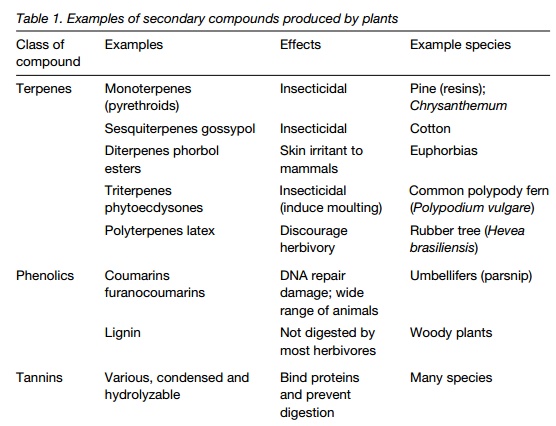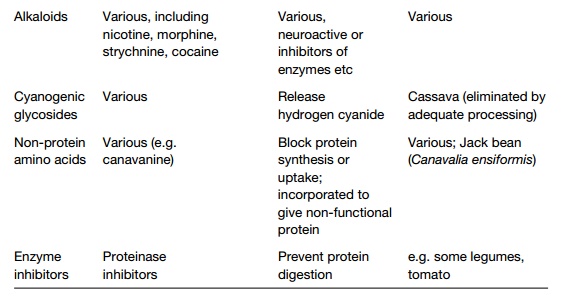Chapter: Plant Biology : Interactions between plants and other organisms
Interactions between plants and animals
INTERACTIONS BETWEEN PLANTS AND ANIMALS
Key Notes
The herbivores
Insects and mammals are important plant herbivores. Many insects are specific to one plant group. Some form galls. Mammals are not as specific, but certain plants are preferred or avoided, particularly by the smaller animals.
Insects and plants
Plant defenses against insects are mainly secondary compounds along with physical defenses such as a thick cuticle. Secondary compounds may be directly toxic, unpalatable or digestion inhibitors. When an insect evolves to be able to utilize one toxic plant group, it may spread and stimulate further evolution. Many plant families are associated with particular insect herbivores. There are more secondary compounds in tropical plants than temperate.
Vertebrates and Plants
Vertebrates influence the entire plant community. Grasses have meristems at nodes and withstand grazing; many grasslands and savannahs are maintained by grazing mammals. Woodlands can be prevented from regenerating and some communities have cyclic patterns. Plants have physical defenses such as spines and stinging hairs as well as secondary compounds. A few plants provide nest sites for aggressive ants which deter animals.
Herbivores and plant Populations
Many plant populations may be controlled in numbers by herbivores, mainly insects, and this is the basis of biological control. If a plant is introduced to an area without its herbivores it may spread to places in which it would not occur in its native region. Monocultures are susceptible to herbivores and in natural communities they stimulate plant diversity. Short-lived plants may live longer if their reproductive capacity is reduced in one season.
The herbivores
Plants provide a wide range of food for animals, and ultimately, all animals rely on plants as the primary producers. A few interactions between animals and their food plants are of mutual benefit, such as the pollination of flowers and dispersal of fruits and seeds (Topics L1 and L2), but most plant–herbivore relationships involve the animal eating and damaging a part of the plant. This usually involves leaves and growing shoots but can involve almost any part of the plant. The most important herbivores of living plants are insects and mammals along with other vertebrates, and molluscs in places. Some invertebrates, including insects such as bugs and grasshoppers eat a range of plants but many insects, particularly the larvae of moths and butterflies, some beetles and others, are specific to one family, genus or even species. They may be abundant on some plants and can defoliate or kill them. Some insects form galls on plants, stimulating the plant to grow unusual structures which enclose the insect larva, e.g. ‘oak apples’ on the European oak, Quercus robur.
Vertebrate herbivores mostly eat a wide range of plants, but in general the smaller the vertebrate the more selective it is. Certain plants are frequently preferred such as many legumes (Fabaceae) which are rich in protein associated with their nitrogen-fixing capacity , or avoided owing to their toxicity, unpalatability (e.g. high silica content) or their physical defenses such as spines. Microorganisms in the gut are vital in the digestion of plant material since vertebrates cannot digest many of the structural molecules that form plants, such as cellulose and lignin, without bacteria.
Insects and plants
Plant defenses against insect herbivores include physical barriers such as a thick cuticle but the most important deterrents are secondary compounds (Table 1;). These must be localized in the plant separately from sites of metabolism, e.g. in the cell wall or vacuole if they are not to be toxic to the cell synthesizing them. They work in many different ways. Some are directly poisonous such as the monoterpene pyrethroids, or indirectly such as thephytoecdysones that mimic insect moulting hormones (ecdysones). Others inhibit digestion, such as tannins or enzyme inhibitors, and others make the plant unpalatable or irritating to the herbivore. In many plants, young leaves are the most nutritious since they are softer than mature leaves, have a greater water content and have fewer secondary compounds. Many insects eat young leaves mostly or exclusively, and insects feeding on mature leaves nearly always grow more slowly.
Insects can evolve the ability to digest the toxic secondary compound in any one plant group, or can eat the leaves avoiding the toxin. Some insects can sequester the toxic substance unchanged in their bodies and use it for their own defense. If an insect group manages to utilize a toxic plant group, the insects are likely to flourish in the absence of competition and the volatile compounds given off by the plant may act as a signal for the insect to find it as a food plant. These interactions normally involve a specialized insect group, such as a family of butterflies, on one plant family. The evolution of insect herbivory in this way resembles an arms race. Plants evolve a novel toxic secondary compound and spread in the absence of much herbivory, then a group of insects evolve the ability to deal with that compound and so spread on the plants. This has happened many times, e.g. the toxic milkweed family is fed on by monarch butterflies; the passion-flowers are food plants for Heliconius butterflies. Many species may be involved. It is a situation in which diversity in one group stimulates diversity in the other and this may be one of the major stimuli for the production of biodiversity generally.
Certain plant families are susceptible to numerous insects, such as the cabbage family, whereas others generally have very few, such as the largely tropical Rubiaceae (which includes coffee). Tropical plants generally have a greater quantity and range of secondary compounds than temperate plants and there is a strong negative correlation between quantity of toxic compounds and latitude. This may be true even within one species, such as the white clover in which some plants are cyanogenic (i.e. producing cyanide, mainly deterring molluscs); in southern Europe almost all plants are cyanogenic, but in northern Europe very few are. This implies that there is a cost to producing secondary compounds .


In temperate latitudes it has been shown that those trees that are most abundant or have been in an area for the longest time have more species of insect herbivore than more recent arrivals or rarer trees.
Vertebrates and plants
Vertebrates can have major effects on the structure of a plant community. Grazing mammals maintain most of the grasslands of the world. Grasses themselves are well adapted to withstand grazing pressure since their meristems are at the nodes rather than the tips of stems . Without the constant presence of grazing mammals, many grasslands would be invaded by shrubs or trees. In many partially wooded areas, such as savannahs, the density of trees is kept low by grazing mammals and in some places there can be cyclic changes in the community with mammals creating open spaces which may then suffer drought. The drought may kill many of the mammals, allowing trees to regenerate. The most significant mammals in these places are the large herbivores, such as elephants, which occurred in almost all regions until their numbers were depleted by humans within the last 100 000 years or so. In all grasslands the particular herbivores present and their relative abundances have a profound effect on the composition of the plant community.
In woodlands, grazing and browsing mammals can prevent regeneration and keep the understorey open. Continuing dense populations of herbivorous mammals can open up a woodland by stopping regeneration. Some mammals, such as pigs, root in the soil and disturb the vegetation allowing gaps to appear for short-lived plants to colonize. Tree-dwelling herbivores, such as sloths and some primates, rarely appear to influence the plant community significantly.
Adaptations by plants to withstand grazing often involve physical defenses. Spines or thorns deter herbivorous vertebrates and are particularly frequent in places where growth is slow such as arid areas. Stinging hairs are a feature of certain families such as the nettle family (Urticaceae). Many plants have thick waxy cuticles, resin ducts or large deposits of silica in their leaves making them unpalatable. Toxic secondary compounds (Table 1) deter many vertebrates in the same way as invertebrates. Many tree leaf herbivores vary their diet to avoid too much of any one compound. Most starch-rich roots and tubers have toxic compounds in them, and for human use these must be reduced by plant breeding or, in cassava, by cooking in a particular way.
A few plants, such as the bullshorn acacia of central America, provide nest sites and oil bodies for aggressive ants which attack any herbivore, vertebrate or invertebrate, and may eat off any invading plant such as a climber as well. In many ways, these ants perform the same function as a secondary compound.
Herbivores and plant populations
Some plant populations may be controlled in their numbers by herbivores. This is the basis of biological control of plant pests. Examples include the reduction of the prickly pear cactus population introduced into Australia when the cactus moth was introduced, and a similar reduction of the introduced European St Johnswort (Klamath weed) in Canada by a Chrysolina beetle. These examples of introduction of a plant across continents without their herbivorous animals show how important such herbivores are; until these ‘experiments’ it was not clear that the herbivores were controlling the plant populations in their native lands. In addition, the St Johnswort apparently changed in its ecology and colonized open places in Canada that it does not occupy in its native Europe. It was reduced to semi-shade by the insect, which preferred open places. Many plants may be controlled in their numbers by herbivorous insects.
Herbivory, particularly of seedlings, along with fungal infection may prevent a plant regenerating or growing near an adult since the adult provides a source for the herbivores. In agriculture, monocultures are always more susceptible to pests than planting many species together and pests can build up in any one place making rotational cropping more effective. In a natural plant community the result will be an increase in plant diversity in the community as a whole, and this may be one of the reasons why tropical rainforests are so diverse.
Some plants, particularly ephemerals and other short-lived plants, may live longer as a result of herbivory. If the flowers or other parts of a shoot are removed and the plant fails to reproduce in any one year or produces below a certain proportion of its potential seeds, it may live a further year or longer.
Related Topics